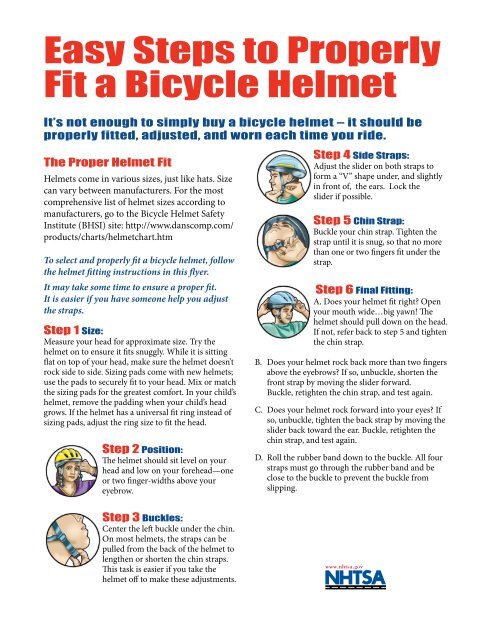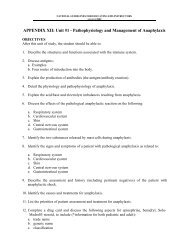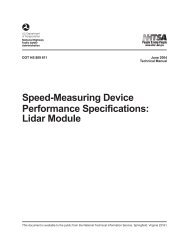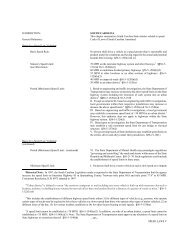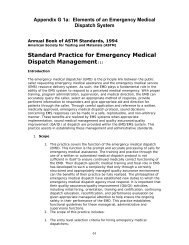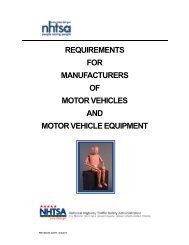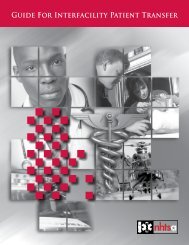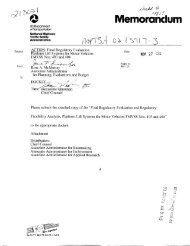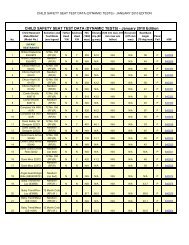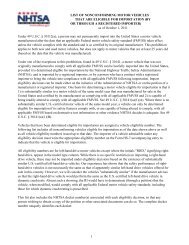Easy Steps to Properly Fit a Bicycle Helmet - NHTSA
Easy Steps to Properly Fit a Bicycle Helmet - NHTSA
Easy Steps to Properly Fit a Bicycle Helmet - NHTSA
Create successful ePaper yourself
Turn your PDF publications into a flip-book with our unique Google optimized e-Paper software.
<strong>Easy</strong> <strong>Steps</strong> <strong>to</strong> <strong>Properly</strong><br />
<strong>Fit</strong> a <strong>Bicycle</strong> <strong>Helmet</strong><br />
It’s not enough <strong>to</strong> simply buy a bicycle helmet – it should be<br />
properly fitted, adjusted, and worn each time you ride.<br />
The Proper <strong>Helmet</strong> <strong>Fit</strong><br />
<strong>Helmet</strong>s come in various sizes, just like hats. Size<br />
can vary between manufacturers. For the most<br />
comprehensive list of helmet sizes according <strong>to</strong><br />
manufacturers, go <strong>to</strong> the <strong>Bicycle</strong> <strong>Helmet</strong> Safety<br />
Institute (BHSI) site: http://www.danscomp.com/<br />
products/charts/helmetchart.htm<br />
To select and properly fit a bicycle helmet, follow<br />
the helmet fitting instructions in this flyer.<br />
It may take some time <strong>to</strong> ensure a proper fit.<br />
It is easier if you have someone help you adjust<br />
the straps.<br />
Step 1 Size:<br />
Measure your head for approximate size. Try the<br />
helmet on <strong>to</strong> ensure it fits snuggly. While it is sitting<br />
flat on <strong>to</strong>p of your head, make sure the helmet doesn’t<br />
rock side <strong>to</strong> side. Sizing pads come with new helmets;<br />
use the pads <strong>to</strong> securely fit <strong>to</strong> your head. Mix or match<br />
the sizing pads for the greatest comfort. In your child’s<br />
helmet, remove the padding when your child’s head<br />
grows. If the helmet has a universal fit ring instead of<br />
sizing pads, adjust the ring size <strong>to</strong> fit the head.<br />
Step 2 Position:<br />
The helmet should sit level on your<br />
head and low on your forehead—one<br />
or two finger-widths above your<br />
eyebrow.<br />
Step 3 Buckles:<br />
Center the left buckle under the chin.<br />
On most helmets, the straps can be<br />
pulled from the back of the helmet <strong>to</strong><br />
lengthen or shorten the chin straps.<br />
This task is easier if you take the<br />
helmet off <strong>to</strong> make these adjustments.<br />
Step 4 Side Straps:<br />
Adjust the slider on both straps <strong>to</strong><br />
form a “V” shape under, and slightly<br />
in front of, the ears. Lock the<br />
slider if possible.<br />
Step 5 Chin Strap:<br />
Buckle your chin strap. Tighten the<br />
strap until it is snug, so that no more<br />
than one or two fingers fit under the<br />
strap.<br />
Step 6 Final <strong>Fit</strong>ting:<br />
A. Does your helmet fit right? Open<br />
your mouth wide…big yawn! The<br />
helmet should pull down on the head.<br />
If not, refer back <strong>to</strong> step 5 and tighten<br />
the chin strap.<br />
B. Does your helmet rock back more than two fingers<br />
above the eyebrows? If so, unbuckle, shorten the<br />
front strap by moving the slider forward.<br />
Buckle, retighten the chin strap, and test again.<br />
C. Does your helmet rock forward in<strong>to</strong> your eyes? If<br />
so, unbuckle, tighten the back strap by moving the<br />
slider back <strong>to</strong>ward the ear. Buckle, retighten the<br />
chin strap, and test again.<br />
D. Roll the rubber band down <strong>to</strong> the buckle. All four<br />
straps must go through the rubber band and be<br />
close <strong>to</strong> the buckle <strong>to</strong> prevent the buckle from<br />
slipping.
^ When <strong>to</strong> Replace a <strong>Helmet</strong>.<br />
Replace any helmet that has been involved in<br />
a crash, or is damaged.<br />
^ The <strong>Helmet</strong> Should <strong>Fit</strong> Now.<br />
Buy a helmet that fits your head now, not a<br />
helmet <strong>to</strong> “grow in<strong>to</strong>.”<br />
Replace any helmet that has been outgrown.<br />
^ The <strong>Helmet</strong> Should Be Comfortable.<br />
If it feels small, put in the thinner sizing pads<br />
or purchase a larger helmet. Ideally, select a<br />
helmet brand and size that fits well prior <strong>to</strong><br />
any adjustments. If you buy a helmet that you<br />
find comfortable and attractive, you are more<br />
likely <strong>to</strong> wear it.<br />
^ The <strong>Helmet</strong> Must Cover Your<br />
Forehead.<br />
^ The Chin Strap Must Be Tight and<br />
<strong>Properly</strong> Adjusted.<br />
^ The <strong>Helmet</strong> Should Not Rock Forward<br />
or Backward on Your Head.<br />
If it does, see step 6.<br />
A bicycle helmet can protect your<br />
head and brain ONLY if you wear it<br />
each time you ride!<br />
<strong>Helmet</strong> Laws<br />
Many States and local jurisdictions have bicycle<br />
helmet laws; please refer <strong>to</strong> your State or local<br />
jurisdiction. To find this information go <strong>to</strong> www.<br />
helmets.org/manda<strong>to</strong>r.htm<br />
A bicycle crash can happen at any time. A properly<br />
fitted bicycle helmet reduces the risk of head injury<br />
by as much as 85 percent and the risk of brain injury<br />
by as much as 88 percent.<br />
More children age 5 <strong>to</strong> 14 go <strong>to</strong> hospital emergency<br />
rooms for injuries associated with bicycles than<br />
with any other sport. Many of these injuries involve<br />
the head. <strong>Helmet</strong> laws ensure the safety of our<br />
children.<br />
Model Safe Behavior<br />
Everyone — adult and child — should wear bicycle<br />
helmets each time they ride. <strong>Helmet</strong>s are the single<br />
most effective way <strong>to</strong> prevent head injuries resulting<br />
from bicycle crashes. Wearing a helmet each ride<br />
can encourage the same smart behavior in others.<br />
<strong>Helmet</strong> Certification<br />
Buy a new helmet that has been tested and meets<br />
the uniform safety standard issued by the U.S.<br />
Consumer Product Safety Commission (CPSC); use<br />
an old helmet only if it has a seal from one or more<br />
of the voluntary bicycle helmet standards, such as<br />
ASTM, Snell, or ANSI. Look for the certification<br />
seal labeled on the helmet.<br />
For more information on bicycle safety, visit the<br />
National Highway Traffic Safety Administration<br />
(<strong>NHTSA</strong>) Web site at: www.nhtsa.dot.gov<br />
DOT HS 810 600<br />
April 2006


